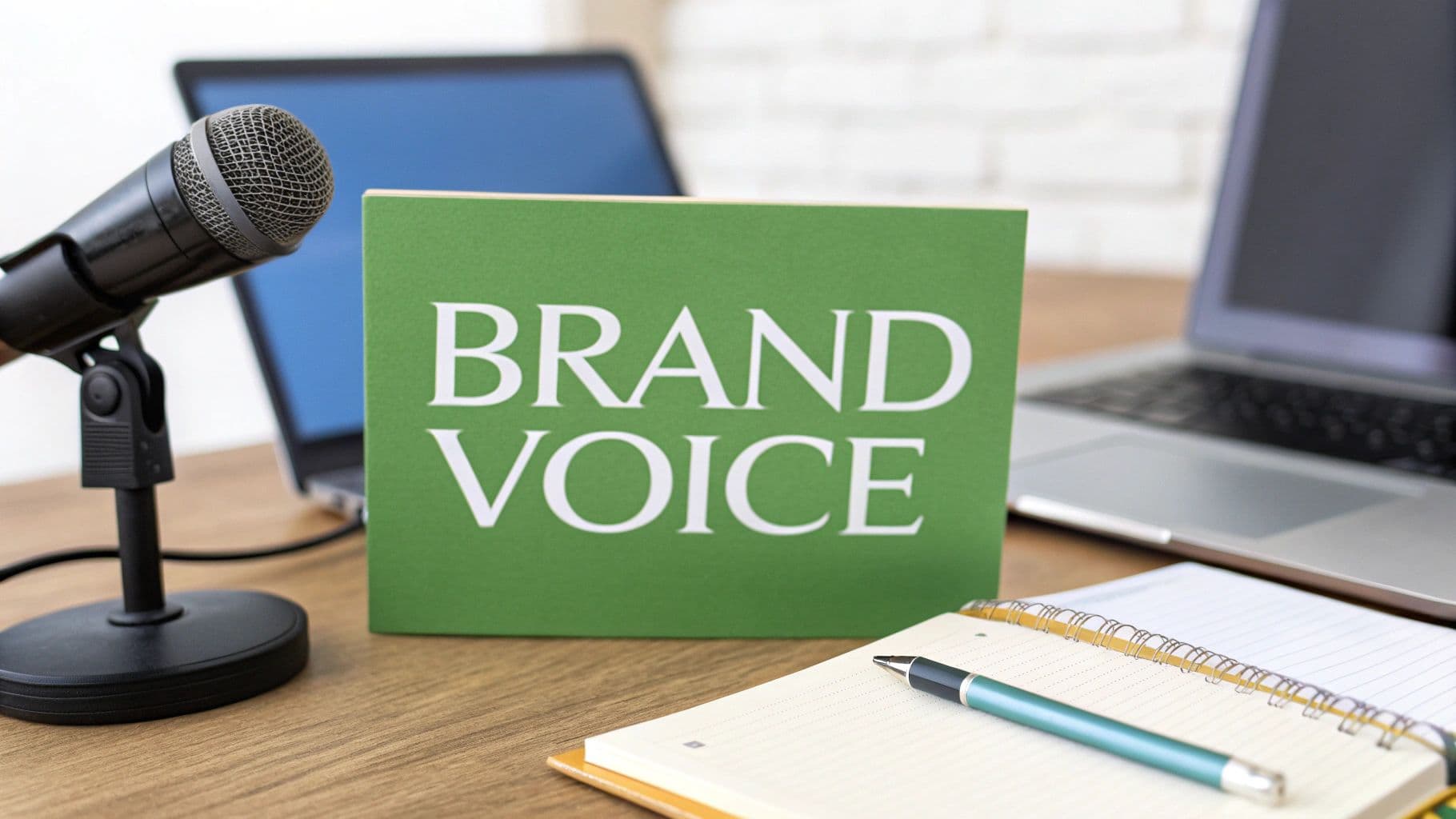
Brand Voice Guidelines: Create Consistent, Trustworthy Messaging
June 10, 2025
Why Brand Voice Guidelines Transform Your Business

In a competitive market, a strong brand presence requires more than visuals. It demands a distinct identity that resonates with your audience. This is where brand voice guidelines become essential. They serve as a blueprint for all communications, ensuring consistency and clarity across every platform. This creates a unified and authentic experience for customers, regardless of where they interact with your brand.
Brand voice guidelines go beyond simple grammar rules. They define your brand's personality and values, shaping how you communicate. Imagine your brand as a person. What would their personality be? Would they be witty, or formal and professional? This "personality" influences every aspect of your messaging, from word choice to overall tone.
The Power of a Consistent Voice
Consistency builds trust and loyalty with customers. A scattered brand voice can confuse customers and erode their confidence. A well-defined and consistently applied voice builds recognition and familiarity, which fosters trust. In fact, 81% of consumers need to trust a brand before purchasing. Branding Statistics. A consistent brand voice plays a key role in building that trust.
Brand Voice as a Competitive Advantage
Strong brand voice guidelines can set you apart in a crowded market. They establish a unique and memorable identity. Imagine two competing coffee shops: one uses generic language, the other a quirky tone reflecting its local, artisanal approach. The distinct voice of the latter is more likely to attract and retain customers.
Key Components of Effective Guidelines
Effective brand voice guidelines usually include several key elements:
- Personality: The core characteristics of your brand's personality (e.g., friendly, professional, humorous).
- Tone: The overall emotional tone of your communications (e.g., optimistic, informative, empathetic).
- Language: Preferred vocabulary, grammar, and style choices.
- Examples: Concrete examples of the brand voice in different contexts.
By defining these elements, you empower your team to communicate with a unified voice. This strengthens your brand identity, resonates with your audience, and ultimately leads to increased brand recognition, customer loyalty, and business growth.
Discovering Your Brand's Authentic Voice
Every brand has a unique personality just waiting to be discovered. The challenge lies in unearthing and defining that authentic voice. It's more than just picking a tone; it's about truly understanding your brand's core identity and how that translates into consistent communication. This section will guide you through proven methods for finding your brand's natural voice, based on your mission, values, and customer relationships.
Understanding Your Brand's DNA
Imagine your brand as a person. What words would you use to describe them? Friendly? Professional? Quirky? These characteristics form the foundation of your brand voice. For example, if your brand were a friend, would they be the life of the party, a quiet listener, or the reliable advisor? This exercise helps reveal your brand's inherent personality.
This initial step offers key insights for creating your brand voice guidelines, a document that acts as a compass for all communications. It's more than a simple style guide; it embodies your brand's personality and directs how your team interacts with customers. These guidelines will influence everything from social media posts to customer service emails.
Translating Values into Voice
Your brand's values are more than just words on a website. They are the fundamental principles guiding your business decisions and interactions. How can these abstract values be transformed into a tangible voice? Consider how your brand embodies these values in action. Does your brand prioritize customer service? This might translate into a helpful and empathetic voice. Is innovation a core value? Then your voice might reflect a forward-thinking and creative personality.
For example, a brand that values sustainability might use language that reflects environmental consciousness, incorporating words like "eco-friendly" and "responsible." A brand focused on luxury might use words like "exclusive," "premium," and "refined," while ensuring its tone matches that high-end image.
Aligning With Your Audience
Understanding your audience is essential. Your brand voice should resonate with their values and expectations, while staying true to your brand's identity. Just like in any conversation, consider who you're talking to. Would they appreciate humor, or would they prefer a more formal tone? Are they seeking practical advice or inspiring content?
This process requires research and empathy. Tools like surveys and focus groups can offer valuable insights into your audience’s communication preferences. Analyzing interactions on platforms like Twitter or Facebook provides real-time feedback on what resonates. Remember to adapt your tone for different channels while maintaining core voice principles.
Testing and Refining Your Voice
Once you have a draft of your brand voice guidelines, it’s time to test their effectiveness. Consider A/B testing different versions of marketing materials to see which voice connects best with your target audience. Gather feedback internally from your team to ensure clarity and ease of implementation. Does your marketing copy feel authentic and engaging? Does your customer service correspondence truly reflect empathy and support?
Just as personal communication evolves, so should your brand voice. Regularly review and refine your guidelines based on performance data and audience feedback. Learn more about refining your writing with Natural Write. This continuous improvement ensures your brand voice remains current, relevant, and makes a strong impact. This ongoing commitment strengthens your connection with your audience and builds a lasting brand identity in the market.
Building Comprehensive Voice Guidelines That Work
What separates truly effective brand voice guidelines from a basic style guide? Actionable guidelines become a living document, guiding your team toward consistent and impactful communication. This section breaks down the essential components, moving beyond simple grammar rules to define the personality and values shaping every interaction. We'll explore how to craft guidelines that ensure consistency while maintaining flexibility across various platforms and contexts.
Key Elements of Comprehensive Guidelines
Your brand voice guidelines should be comprehensive enough to cover every communication scenario. This involves outlining not only the what but also the how.
Personality Descriptors: Defining the core characteristics of your brand's persona (e.g., friendly, authoritative, innovative). Imagine your brand as a person; how would you describe their character?
Tone Guidelines: Specifying the emotional feel of your communications (e.g., optimistic, informative, humorous). Tone can vary based on context, so provide examples for different situations.
Language Choices: Detailing preferred vocabulary, grammar, and sentence structure. Are you aiming for concise, impactful language or a more conversational, friendly approach?
Communication Principles: Articulating your overarching communication philosophy. This might involve prioritizing clarity, empathy, or transparency. For example, do you aim to empower customers through education or inspire them through storytelling?
Do's and Don'ts: Providing clear examples of both successful and unsuccessful implementations. This helps your team understand the nuances of your brand voice and avoid common pitfalls.
To improve your writing, you might find this helpful: How to master making your writing sound better
Visualizing Voice Guidelines in Action
The following infographic illustrates how a consistent brand voice can be applied across various platforms while maintaining a high level of tone consistency. It showcases the distribution of brand voice usage and its impact on overall brand messaging.

As the infographic shows, social media accounts for 40% of brand voice usage, followed by email at 35% and blog content at 25%. This distribution highlights the importance of consistent messaging across multiple channels. Achieving an 85% overall tone consistency score demonstrates the effectiveness of well-defined brand voice guidelines in maintaining a unified brand identity.
Creating Usable and Adaptable Guidelines
Guidelines shouldn't be static documents. They should be adaptable and easy to use in various contexts. This means providing practical templates and real-world examples that demonstrate how your brand voice translates across different channels. For example, showcase how your brand's "friendly" personality might manifest in a social media post versus a customer service email. The key is to offer enough detail for consistency, yet allow for flexibility to prevent your content from sounding robotic or forced. This allows your team to tailor communications while staying true to the overarching brand voice.
To further illustrate the key differences between basic style guides and comprehensive brand voice guidelines, let's examine the following comparison:
Brand Voice Components Comparison
A detailed comparison of essential elements found in successful brand voice guidelines versus basic style guides
| Component | Basic Style Guide | Comprehensive Voice Guidelines | Impact on Consistency |
|---|---|---|---|
| Grammar & Mechanics | Detailed rules and examples | Included, but emphasis on how these support the overall voice | Ensures basic correctness but may lack personality |
| Tone | Briefly addressed | Defined in detail, with examples for various contexts (e.g., social media, customer service) | Significantly improves consistency in conveying emotion and brand personality |
| Vocabulary | Preferred terms listed | Preferred terms linked to brand values and personality, with examples of how they are used | Creates a more distinct and recognizable brand voice |
| Brand Personality | Minimal or no mention | Clearly defined with descriptive adjectives and examples | Helps ensure all communications reflect the intended brand image |
| Values | May be listed separately | Integrated into the voice guidelines, showing how values inform communication choices | Strengthens the connection between brand values and how the brand communicates |
This table highlights the crucial role of comprehensive voice guidelines in establishing a consistent brand identity. By going beyond basic grammar and style, these guidelines help ensure that every communication, regardless of the channel, accurately reflects the brand's personality and values.
Matching Your Tone To Your Audience

Understanding your audience is crucial for creating effective brand voice guidelines. Just as you adjust your communication style with friends and colleagues, your brand must adapt its voice to resonate with its target market. This means understanding not only who your audience is but also their preferred communication style. This section delves into the psychology of different brand tones and how they shape customer perception.
The Psychology of Tone
Different tones elicit different emotional responses. A formal tone projects authority and professionalism, making it suitable for sectors like finance or law. Conversely, a casual, friendly tone might work better for a lifestyle brand targeting a younger demographic. A tech startup, for example, might use a playful tone to engage early adopters. Meanwhile, a healthcare provider would likely choose an empathetic, reassuring tone to build trust. Selecting the right tone is essential for forging emotional connections and influencing how customers perceive your brand.
Matching Tone to Audience Preferences
Imagine a skateboard company using stiff corporate jargon in its marketing. The mismatch would be jarring and ineffective. This highlights the importance of aligning your tone with your audience's preferences. Researching your target demographic—their values, interests, and communication styles—is key. This might involve analyzing their social media interactions, conducting surveys, or using focus groups to gather valuable insights. For further guidance on refining your writing, you might find this helpful: How to improve your writing skills.
Adapting Tone Across Channels
Maintaining a consistent brand voice is vital. However, your tone should adapt across different communication channels. Your approach on Twitter will likely differ from your style on LinkedIn or in a formal email newsletter. Emojis and informal language might be appropriate for social media. However, a more professional tone is generally expected for email or business proposals. This flexibility allows you to tailor your message to the platform while staying true to your brand identity.
Your tone should also align with industry expectations and your business objectives. A luxury brand might employ a sophisticated tone to emphasize exclusivity. A budget-friendly brand, on the other hand, might opt for a more approachable, value-driven style. Furthermore, certain tones have a measurable impact. 61% of audiences find warm and inviting tones influential, while 60% respond well to tones that convey history and trust, as of 2025. Find more detailed statistics here. This underscores the importance of tone as a strategic tool for influencing customer behavior and driving conversions.
Testing and Refining Tone Effectiveness
Developing your brand voice guidelines is an ongoing process. Just as your business adapts to market changes, so should your communication strategy. Regularly assess the effectiveness of your tone by analyzing customer feedback and engagement metrics. This could involve A/B testing different marketing copy or monitoring social media responses. This continuous refinement ensures your brand voice remains relevant and resonant, fostering strong emotional connections with your target audience.
Rolling Out Guidelines Across Your Organization
Creating brand voice guidelines is a crucial first step. But the real challenge lies in implementing them effectively throughout your organization. This involves a strategic rollout and consistent commitment from every team, from marketing to customer service. This section offers a practical guide for introducing and maintaining your brand voice guidelines, ensuring consistent application across all communication channels.
Training Your Team for Success
Effective implementation starts with thorough training. Every team member, particularly those interacting directly with customers, needs a deep understanding of the guidelines. This goes beyond simply sharing the document. Interactive workshops and practical exercises can be valuable. For instance, role-playing different scenarios can help employees practice using the brand voice in realistic customer interactions, such as responding to complaints or crafting social media posts.
This training should cover the core components of your brand voice guidelines: personality traits, tone, language choices, and communication principles. Addressing any potential confusion and answering questions will ensure everyone feels comfortable applying the guidelines in their daily work.
Establishing Accountability and Support
Guidelines are only effective with the right support systems in place. Establish clear accountability for maintaining brand voice consistency. Consider designating brand voice champions within each department to monitor adherence and offer guidance. Creating an easily accessible resource library with helpful templates and examples can also empower team members to implement the guidelines effectively.
Implementing brand voice guidelines is an ongoing process. Regular check-ins and consistent support are key, especially as your team expands or your brand evolves. This reinforcement underscores the importance of the guidelines and helps maintain their long-term effectiveness.
Ensuring Consistent Application Across Touchpoints
A unified brand voice requires consistency across all customer touchpoints. This includes everything from email marketing and social media to website copy and customer support interactions. For example, ensuring your "helpful" brand personality is evident in both a blog post and a customer service email strengthens the overall brand experience.
This level of consistency requires clear communication and collaboration between departments. Regularly auditing different communication channels can help identify areas for improvement and ensure adherence to the guidelines. Prioritizing consistency creates a seamless and recognizable brand experience, fostering trust and loyalty with your audience.
Addressing Common Implementation Challenges
Introducing brand voice guidelines often comes with challenges. Some team members might resist change, while others may find it difficult to adapt the voice to different situations. Address these challenges directly by providing ongoing support and opportunities for feedback.
Also, recognize that your brand voice is not static. It should evolve alongside your business and audience. Establish procedures for regularly reviewing and updating your guidelines based on performance data, customer feedback, and market trends. This keeps your brand voice fresh and relevant while maintaining its core identity.
Building a Feedback Loop for Continuous Improvement
A system for gathering feedback is essential for both maintaining consistency and improving your brand voice guidelines. Regularly seek feedback from both internal teams and external customers through methods like surveys, focus groups, or simply encouraging open communication.
This feedback loop offers valuable insights into what’s working and what needs improvement, enabling you to make data-driven adjustments. By continually refining your brand voice based on this feedback, you ensure it remains aligned with your target audience and supports your business goals.
Measuring Success and Maintaining Consistency

Having solid brand voice guidelines is a crucial first step. But how can you tell if they're truly effective? This section dives into establishing clear metrics and implementing reliable monitoring systems to gauge the impact of your voice strategy. It's all about ensuring your carefully crafted voice resonates with your audience and consistently represents your brand everywhere it appears.
Defining Key Performance Indicators (KPIs)
Just like any other strategic initiative, measuring the success of your brand voice relies on tracking the right Key Performance Indicators (KPIs). These metrics provide concrete data that illustrates how your voice influences your audience and contributes to your business objectives. Are you seeing a boost in social media engagement? Has customer satisfaction improved since you rolled out your new voice guidelines?
Identifying the most relevant KPIs depends on your specific goals.
- Engagement: Consider metrics like likes, shares, comments, and retweets on social media.
- Sentiment Analysis: Gauge the positive, negative, or neutral sentiment expressed in customer feedback.
- Website Traffic: Analyze how your brand voice affects website visits and bounce rates.
- Conversion Rates: Track how your voice influences key conversions like sales, lead generation, or sign-ups.
- Customer Satisfaction: Monitor customer feedback through surveys and reviews.
Tools and Techniques for Monitoring
A range of tools can help you keep tabs on these important KPIs. Social media analytics dashboards offer valuable insights into engagement and sentiment. Website analytics platforms like Google Analytics can show you how your brand voice affects website traffic and conversions. Don't forget the power of survey tools to gather direct feedback from your customers.
Conducting Regular Voice Audits
Consistency is the cornerstone of a successful brand voice. Regular audits help ensure your guidelines are being followed across all your communication channels. This means reviewing a variety of materials.
- Social Media Posts: Is the tone, language, and personality consistent?
- Marketing Emails: Does the voice align with your brand's identity?
- Website Content: Does your web copy truly reflect your brand's personality?
- Customer Service Interactions: Are your support teams embodying your brand's values?
Audits can be handled internally or by external agencies. The ideal frequency depends on factors like the size of your organization and how much you're communicating. However, strive for at least quarterly reviews to maintain consistency and pinpoint areas for improvement. Learn more about refining AI-generated content in our article about humanizing AI-generated text.
Gathering Feedback and Making Adjustments
Brand voice guidelines shouldn't be set in stone. They need to evolve alongside your business and your audience. Gathering feedback, both from your customers and your internal team, is crucial for continuous improvement.
Consider using regular surveys to understand how your audience perceives your brand voice. Encourage your internal teams to share their experiences using the guidelines. This feedback loop provides invaluable data for refining your voice and adapting to shifts in the market.
Maintaining Consistency While Staying Fresh
While consistency is paramount, it's equally important to keep your brand voice fresh and engaging. Your guidelines should provide room for flexibility and creativity within the defined framework. This prevents your communications from becoming predictable or stale.
Experiment with new content formats or explore current themes within the boundaries of your established voice. This balance between consistency and innovation keeps your brand voice dynamic and relevant.
To help you measure your brand voice effectiveness, let's take a look at some key metrics.
Brand Voice Success Metrics
Key performance indicators and measurement methods for evaluating brand voice effectiveness and consistency
| Metric Category | Specific KPIs | Measurement Method | Frequency |
|---|---|---|---|
| Engagement | Likes, Shares, Comments, Retweets | Social Media Analytics | Weekly/Monthly |
| Sentiment | Positive, Negative, Neutral Feedback | Sentiment Analysis Tools, Surveys | Monthly/Quarterly |
| Website Traffic | Website Visits, Bounce Rate, Time on Page | Google Analytics | Weekly/Monthly |
| Conversions | Sales, Leads, Sign-Ups | CRM, Marketing Automation Platforms | Weekly/Monthly |
| Customer Satisfaction | Customer Satisfaction Score (CSAT) | Surveys, Reviews | Quarterly/Annually |
This table offers a practical framework for measuring the effectiveness of your brand voice guidelines. By tracking these metrics and actively gathering feedback, you can ensure your brand's voice consistently resonates with your target audience and drives your business goals forward.
Key Takeaways
Your brand voice is the personality and tone that permeates every communication. Think of iconic brands like Nike, with its motivational and empowering voice, or Dove, emphasizing real beauty and self-acceptance. These brands consistently project their values and personality, fostering trust and lasting brand recognition. This section outlines key steps to achieve similar success with your brand voice.
Essential Actions for Building a Strong Brand Voice
Implementing brand voice guidelines requires a strategic approach. Here's how to begin:
Define Your Brand Personality: Just as individuals have unique personalities, so does your brand. Is it friendly, professional, quirky, or innovative? Defining these core traits forms the foundation for consistent communication.
Craft Your Tone of Voice: Tone conveys emotion and influences audience perception. A formal tone might suit financial services, while a playful tone could work for a lifestyle brand. Choose a tone aligning with your brand personality and resonating with your target audience.
Develop Comprehensive Guidelines: Clearly document your brand voice, encompassing everything from personality and tone to language and examples. Make these guidelines accessible to your entire team as a practical communication guide.
Train Your Team: Equip your team with the resources to apply your brand voice guidelines effectively. Interactive workshops, practical examples, and ongoing support ensure consistent application.
Establish Accountability: Appoint brand voice champions within each department to monitor adherence and provide support. This reinforces consistency and ensures practical implementation of your guidelines.
Building Your Brand Voice Guidelines
Creating effective brand voice guidelines requires a structured approach. Use this checklist:
Audience Analysis: Understand your target audience deeply. What are their values, interests, and communication preferences?
Brand Values: Define your brand's core values. These principles should inform all communication, ensuring authenticity and consistency.
Competitor Analysis: Analyze your competitors' communication. This helps identify opportunities to differentiate your brand voice and stand out.
Tone and Language: Specify your brand's tone of voice and preferred language. Provide clear examples to illustrate practical application.
Do's and Don'ts: Create a clear list of do's and don'ts for your team. This helps prevent mistakes and reinforces your desired communication style.
Measuring Your Brand Voice Success
How can you tell if your brand voice guidelines are effective? Track these key metrics:
Engagement: Monitor social media engagement (likes, shares, comments) to assess audience response.
Sentiment Analysis: Analyze customer feedback to understand the emotional reaction to your communications.
Website Traffic and Conversions: Track website activity to see how your brand voice influences user behavior.
Customer Satisfaction: Measure customer satisfaction via surveys and reviews to gauge your voice's impact on customer experience.
Maintaining Consistency and Adaptability
While consistency is crucial, your brand voice should remain adaptable. Regularly review your guidelines, gather team and customer feedback, and update your approach as needed. This ensures your brand voice remains relevant and resonant, fostering strong connections with your audience.
Ready to refine your content and ensure it sounds authentic? Check out Natural Write – your free tool for creating engaging content.


